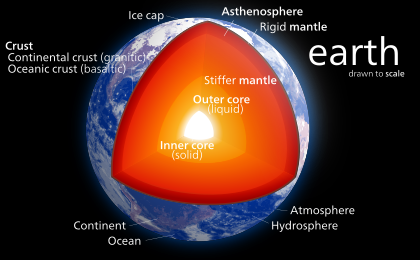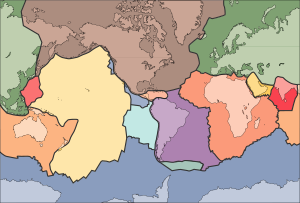Internal structure of Earth facts for kids
The internal structure of Earth is like an onion, with many layers inside. It's everything inside our planet, except for the air (atmosphere) and water (hydrosphere). These layers include the solid crust we live on, a thick mantle that can slowly flow, a liquid outer core that creates Earth's magnetic field, and a solid inner core at the very center.
Scientists learn about Earth's inside by studying seismic waves from earthquakes. They also look at rocks that come up from deep inside, measure Earth's gravity and magnetic field, and do experiments with materials under extreme pressure and heat.
Contents
Earth's Amazing Layers

Earth is made of several layers, each with different properties. We can think of these layers in two ways: by how they behave (like being solid or liquid) or by what they are made of (their chemical makeup).
When we look at how they behave, Earth has the lithosphere, asthenosphere, mesospheric mantle, outer core, and inner core. When we look at their chemical makeup, Earth has the crust, upper mantle, lower mantle, outer core, and inner core.
The Crust: Our Home Layer
The Earth's crust is the outermost layer, where we live. It's like the skin of an apple. Its thickness varies a lot.
- Oceanic crust is thinner, about 5 to 10 kilometers (3 to 6 miles) thick. It's found under the oceans and is made of dense, dark rocks rich in iron and magnesium.
- Continental crust is thicker, from 5 to 70 kilometers (3 to 43 miles) thick. It makes up the continents and is lighter, made of rocks rich in elements like feldspar and quartz.
The crust and the very top part of the mantle together form the lithosphere. This lithosphere is broken into large pieces called tectonic plates. These plates are always moving, causing earthquakes and volcanoes.
Most rocks in Earth's crust are less than 100 million years old. However, some tiny mineral pieces found are about 4.4 billion years old. This tells us that Earth has had a solid crust for a very, very long time!
The Mantle: Earth's Thickest Layer
The Earth's mantle is the layer beneath the crust. It's the thickest layer of our planet, extending down to about 2,890 kilometers (1,796 miles). That's almost half of Earth's total radius!
The mantle is mostly made of silicate rocks, which are richer in iron and magnesium than the crust. Even though it's solid, the mantle is extremely hot. Over very long periods, this hot rock can slowly flow, like super-thick syrup.
This slow movement in the mantle is called convection. It's like boiling water, where hot material rises and cooler material sinks. This convection is what drives the movement of the tectonic plates on the surface. The heat for this comes from leftover heat from Earth's formation and from the decay of radioactive isotopes inside the Earth.
The deeper parts of the mantle flow less easily because of the immense pressure. The mantle's "stickiness" (viscosity) is incredibly high, much higher than water or even thick tar.
The Core: Earth's Hot Center
The core is at the very center of Earth, divided into two parts: the outer core and the inner core.
The Outer Core: A Liquid Metal Ocean
The Earth's outer core is a liquid layer, about 2,400 kilometers (1,491 miles) thick. It's mostly made of iron and nickel. This liquid layer is located about 2,890 kilometers (1,796 miles) below Earth's surface.
The movement of this liquid iron and nickel in the outer core creates Earth's powerful magnetic field. This field protects us from harmful radiation from space.
The Inner Core: A Solid Metal Ball
The Earth's inner core is the very center of our planet. It's a solid ball, about 1,220 kilometers (758 miles) in radius. This is about 70% the size of the Moon!
The inner core was discovered in 1936 by a scientist named Inge Lehmann. It's mostly made of iron and some nickel. Because it can transmit certain types of seismic waves, scientists know it must be solid, even though it's incredibly hot.
Scientists believe that when Earth first formed, about 4.6 billion years ago, heavier materials like iron and nickel sank to the center. Lighter materials moved towards the surface, forming the crust. This process is called planetary differentiation.
Experiments show that the inner core might be made of giant iron crystals lined up from north to south. This is still an area of active research!
How We Know: Seismology
Scientists learn about Earth's layers by studying seismic waves. These are waves of energy created by earthquakes that travel through the Earth.
- When seismic waves hit a boundary between different layers, they can either refract (bend) or reflect (bounce back).
- Different layers allow waves to travel at different speeds. For example, the core does not allow certain types of waves (shear waves) to pass through it, which tells us it's liquid.
- By carefully measuring how long it takes for these waves to travel and how they change, scientists can create a detailed picture of Earth's hidden layers. It's like using sound waves to map the inside of something you can't see!
See also
 In Spanish: Estructura de la Tierra para niños
In Spanish: Estructura de la Tierra para niños
- Hollow Earth
- Geological history of Earth
- Lehmann discontinuity
- Rain-out model
- Travel to the Earth's center
- Solid earth





